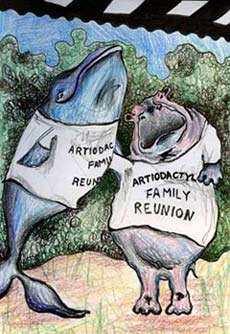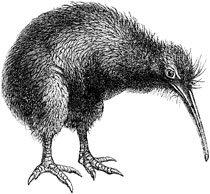|
Enjoy these strange and fascinating stories of the animal kingdom’s shared evolutionary history!
 Hippos and Whales: Many scientists believe that whales and hippos share an ancestor, which lived 50 to 60 million years ago. Hippos and Whales: Many scientists believe that whales and hippos share an ancestor, which lived 50 to 60 million years ago.
This ancestor evolved into two groups of animals—early cetaceans, which became completely aquatic, and land animals called anthracotheres.
The only surviving descendent of the anthracotheres is the hippo! While scientists once believed that pigs and hippos were cousins, recent studies show that hippos have far more in common with whales.
Bats and Insects: Bats evolved roughly 50 million years ago, during a brief period in the Eocene Epoch when the average global temperature raised about 9 degrees Fahrenheit. Some scientists believe that the sharp rise in temperatures enabled insect populations to flourish. In response, bats evolved special characteristics, including flight and echolocation, which enabled them to make use of this enormous food source. This is an example of co-evolution!
Walruses and Bears: The pinnipeds (seals, walruses, and sea lions) evolved roughly 30 million years ago from a bear-like carnivorous ancestor. Modern bears are also descendants of this prehistoric creature! Strangely enough, despite superficial similarities, otters are more closely related to weasels, minks, and badgers than they are to the pinnipeds. Otters resemble pinnipeds because of “convergent evolution,” when animals evolve similar traits because they must adapt to similar environments.

Kiwis and Mammals: Until 1,000 years ago, when humans came to New Zealand , very few mammals lived on the islands. Kiwis evolved on these islands to fill the empty niche of burrowing mammals, and adapted many mammalian traits. Unlike  most birds, kiwis are flightless, nocturnal, and navigate using their strong senses of hearing and smell and sensitive whiskers. They also dig burrows, have mammal-like body temperatures and two functioning ovaries (birds usually have just one). For these reasons and more, these fascinating birds are sometimes called “honorary mammals.” most birds, kiwis are flightless, nocturnal, and navigate using their strong senses of hearing and smell and sensitive whiskers. They also dig burrows, have mammal-like body temperatures and two functioning ovaries (birds usually have just one). For these reasons and more, these fascinating birds are sometimes called “honorary mammals.”
Flamingos, Doves, and Dodos: Archeologists have found primitive flamingo fossils that date back 50 million years! 30 million year old flamingo fossils appear to be almost identical to the present-day birds. The fossils show that the birds were more widespread in the past, and even lived in North America. Their former range suggests that their habitats, shallow wetlands in warm-temperate to tropical climates, were more abundant millions of years ago.
Recent studies suggest that flamingos and pigeons are related! Unlike most birds, doves, pigeons, and flamingos produce a substance called “crop milk” to feed their young. Crop milk is made of shed fluid-filled cells from the lining of part of their digestive tract. Both sexes give off this nutritious substance to feed their hatchlings.
The dodo's closest living relative is Southeast Asia's Nicobar Pigeon. Scientists believe that the dodo separated from its pigeon relatives roughly 40 million years ago, before flying across the Indian Ocean to the Mascarene Islands. Who would have thought that these 50 pound, flightless birds could be related our pigeon neighbors?

Platypuses and Mammals: While human gender is determined by two chromosomes (x,y) platypus gender is dictated by 10 (xxxxx, yyyyy)! Males produce two kinds of sperm: those that have xxxxx yield female young, while those that have yyyyy produce males. While some of the platypus' x chromosomes resemble those of humans, others resemble those of birds. This suggests that mammal sex chromosomes may have evolved from an ancient bird-like system.

|
